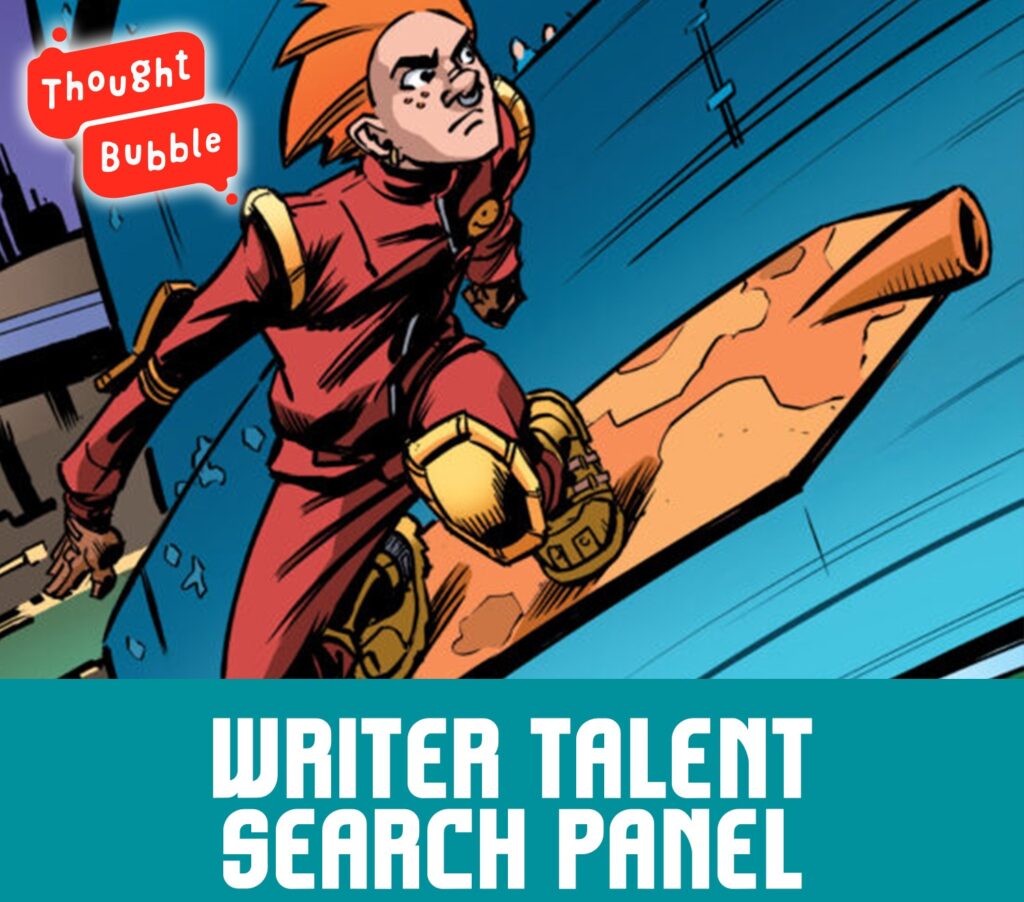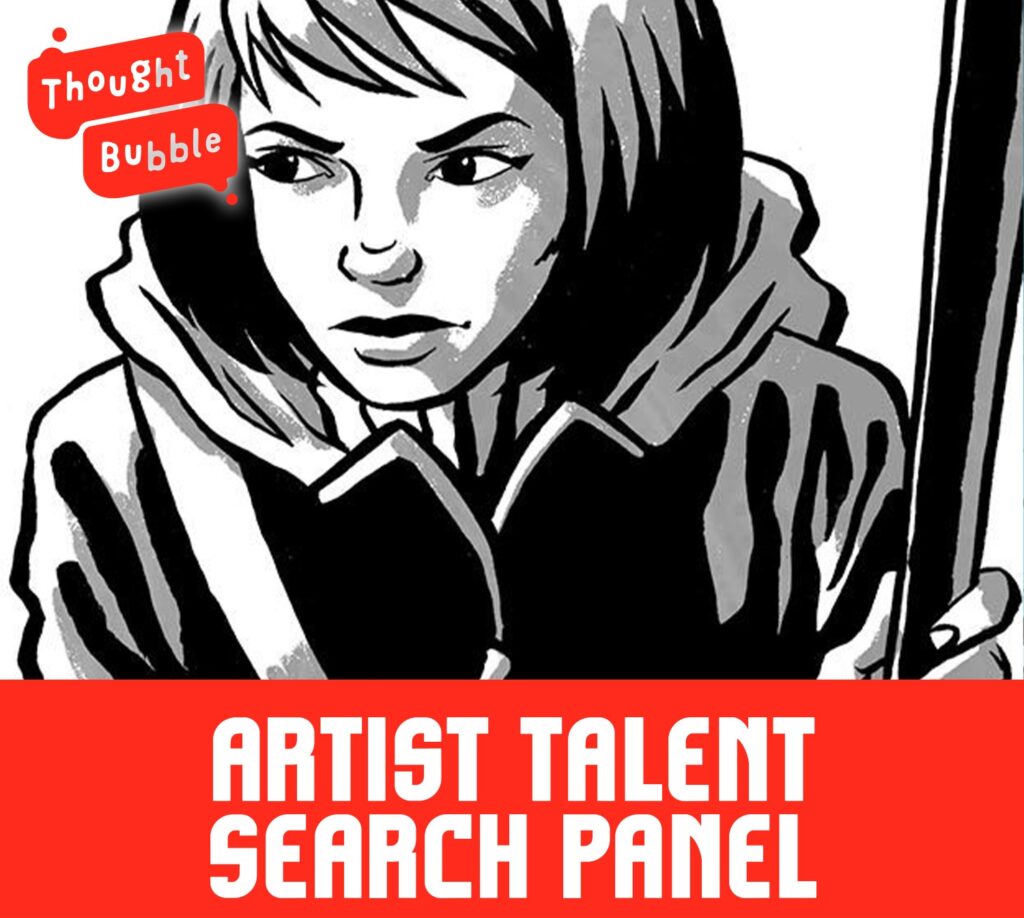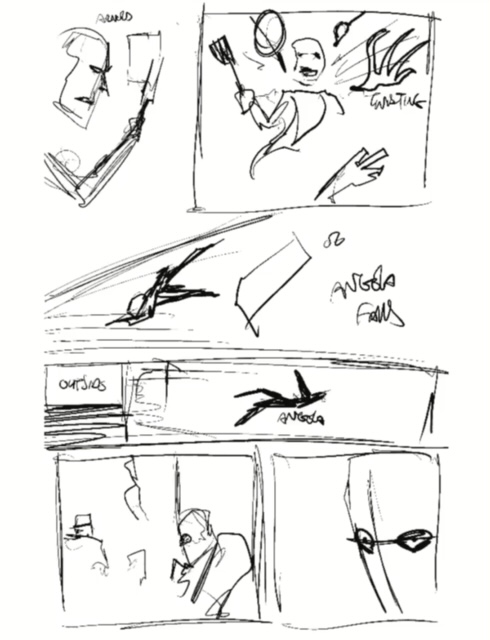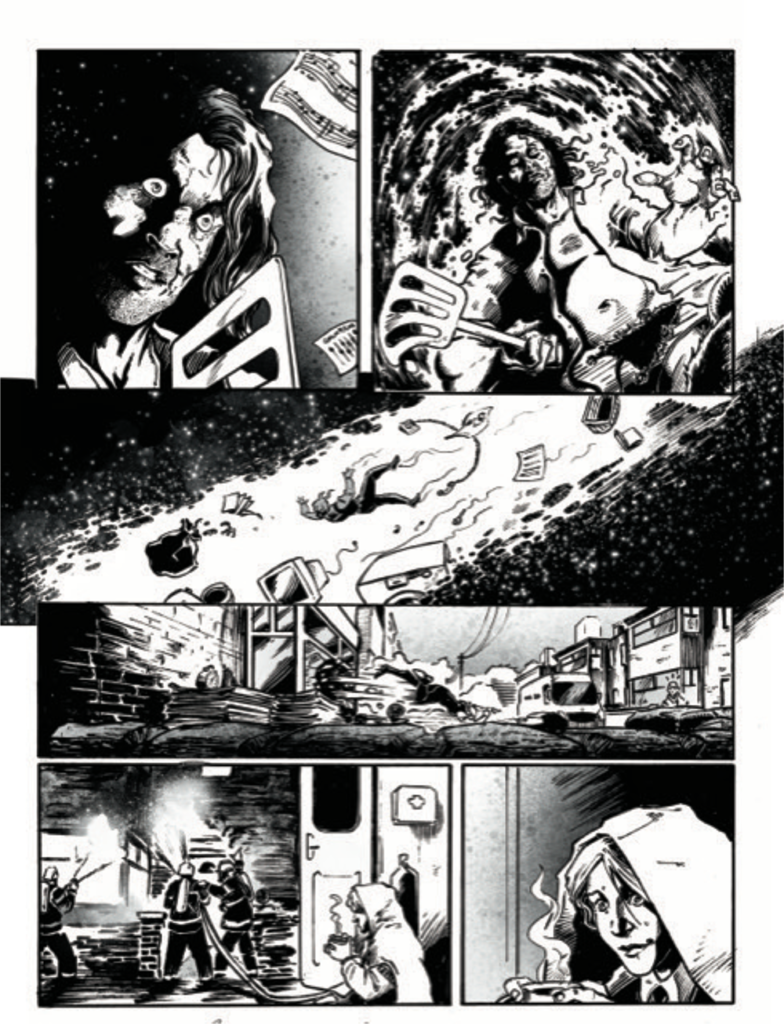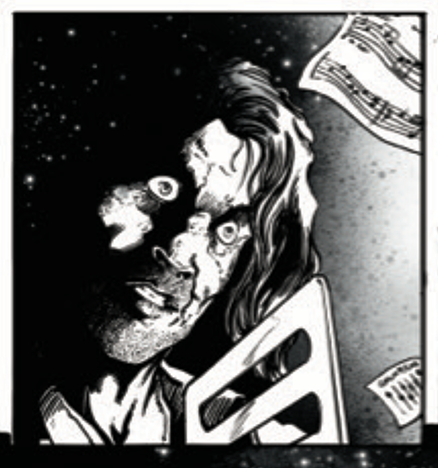Interview: Talking 2000 AD Triumph at Thought Bubble 2022 with Mike Walters and Tom Watts
12th December 2022
This year 2000 AD returned to Harrogate’s Thought Bubble convention in person for the annual art and script convention to pick the droids of the future!
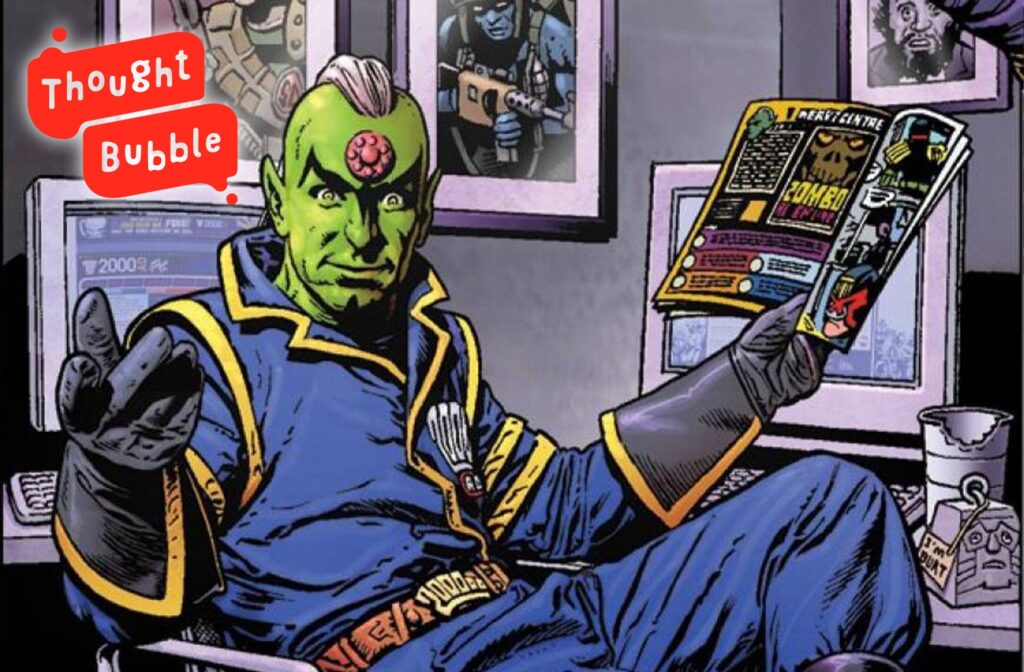
It’s the only talent search of its kind in the UK, with the prizes being paid work with the Galaxy’s Greatest Comic. Previous winners who have gone on to great things include Paul Starkey, James Newell, Rory McConville, Laura Bailey, Will Morris, and Tom Foster, all of whom saw their work in the pages of 2000 AD with a Future Shock and many of whom have become regulars in the Prog and the Judge Dredd Megazine.
Before this year’s judges, 2000 AD editor and writer Matt Smith, writers Leah Moore, John Reppion and Al Ewing, prospective script droids have a two-minute live pitch for a four-page Future Shock. As for the brave souls looking to become the next of Tharg’s art droids, they had to draw pages from writer Kek-W’s Tharg’s Terror Tales: Music Of The Spheres, originally drawn by Dan Cornwell. Matt Smith worked his way thorugh a huge line of contestants to whittle them down to seven to go before the live audience and the judging panel of artists Steve Yeowell, Liana Kangas and Anna Morozova. The judges dissected each of the seven, giving advice and ideas to all the artists before choosing just one winner.
And those winners this year are… drum roll please… Tom Watts for the script contest, whose pitch for a Future Shock will be published in a future Prog, and artist Mike Walters, who will illustrate Tom’s Future Shock. Congratulations to them both and welcome to the family of Tharg!
Tom & Mike, first of all, huge congratulations to you both for vanquishing all of your rivals and impressing our lord and master Tharg enough to win the script and the art contest at Thought Bubble.
It’s been a couple of weeks now, so I suppose the most obvious question is whether it’s all sunk in yet and quite what it means to you to have won?
TOM WATTS: I think I’m still in shock that I was able to pitch, never mind winning! It certainly means a lot to be able to write for the galaxy’s greatest comic. My father was a huge 2000 AD fan when he was growing up, and he instilled in me a love of reading and telling stories. I’ve been training for years on how to write and sought advice from many professionals, so to be able to get a story published finally in 2000 AD is a dream.
MIKE WALTERS: It’s still not even remotely sunk in yet, still can’t quite believe it, from the announcement that I’d won to now, it all feels like a very surreal dream that I’ll wake up from at any moment.
Had you entered the contests before or was this your first time – and how did you find out about the talent search?
TW: This was my first time entering the competition, and I really didn’t know what to expect. Although I’ve been writing and getting feedback for six years, I felt I was ready to put my story skills to the test. My father sent me the link to be able to pitch at Thought Bubble and I decided it would be a good way to get feedback from professionals and gauge where my gaps were.
MW: I’ve only entered once before way back in 2017 which is when I first learned of it, myself and two friends (one of whom now has a few Future Shocks under his belt) went to Thought Bubble thinking we might get to the judging panel at least, the reality was that we weren’t nearly as good as we thought we were at the time. I guess we needed the wakeup call at the time because I’d say my work has improved exponentially since then. At the time my friends and I were expecting to do well from it, I look back at the work now and it’s actually quite funny because I just think honestly, you’ve got to be joking haha.

What was the process of getting to the final like and how daunting was it to be the first set of entrants for a couple of years to be back in front of a live audience and live judges?
TW: I must admit, I tried not to think about the time gap between the last set of live pitches. My main focus was to get there early enough and to just have as much fun as I could! Speaking in front of a whole room of strangers is always difficult, but I figured that even if I pitched and failed, the experience would have helped me grow as a person.
MW: I came to Thought Bubble this year with much more realistic expectations than I did back in 2017, thinking that I’d at least get some good feedback, but I thought that would be it. So once Tharg himself told me I’d been put through to the judging panel, the feeling was at first an almost childlike excitement, followed by an immediate sense of dread (no pun intended). It was made worse once I jumped on Twitter later that day to see that all of the judging panel were artists whose work I admired.
Tom, can you tell us a bit more about what the whole pitching process involved from your perspective?
I think my favourite pitching technique I’ve heard so far has to be from Laura Bailey who pitched without notes and was determined to practice under different pressures – including having her friend Soph heckle her and continuously play the countdown music while Laura pitched drunk. It’s certainly an interesting way to be sure that you’ve got it nailed down and I suppose you could technically count the booze as a writing aid for tax purposes!
TW: I certainly like the way Laura thinks! Like Laura, I wanted to pitch my story live and without a script. This way I felt that I could better communicate my love of the idea. This meant ninety per cent of my preparation involved cutting unnecessary details. Like the end product itself, I needed to show the whole story and twist with just the most significant moments. Then I practiced this on repeat to a timer and, once I felt I was ready, the rest was up to fate.
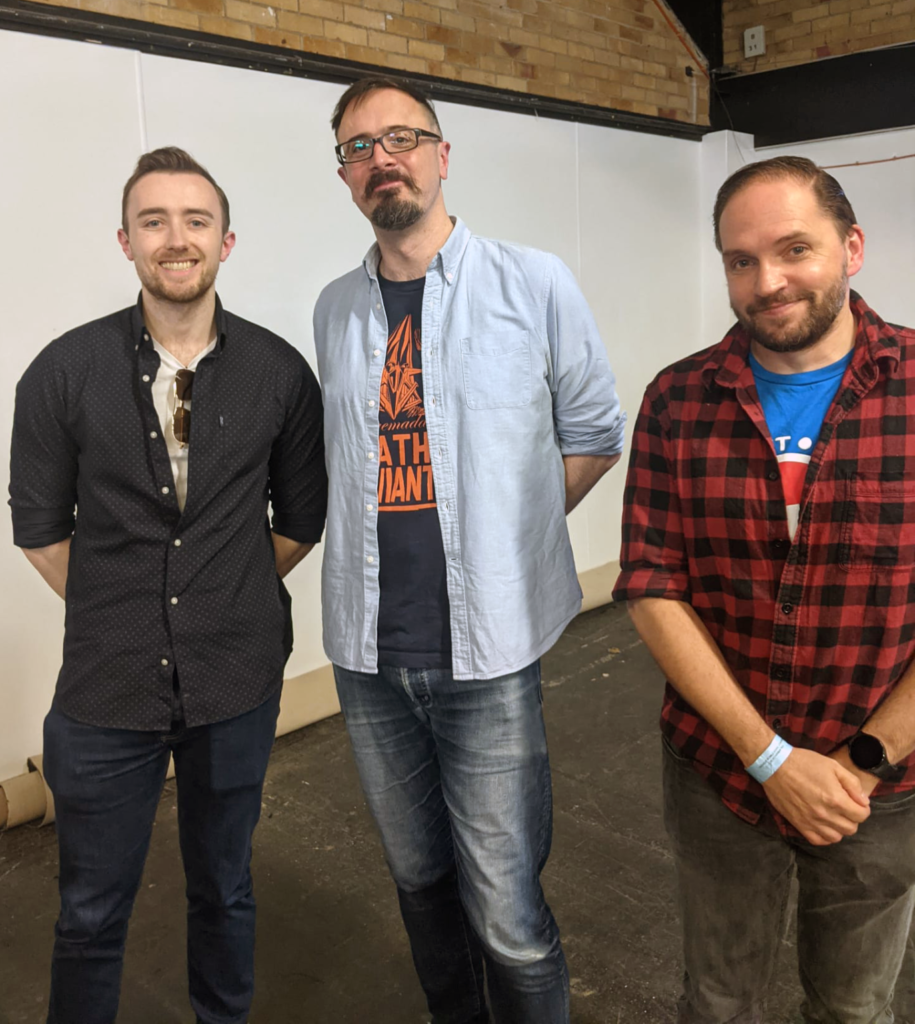
with 2000 AD’s Mike Molcher and Matt Smith
Tom, it’s obviously going to be a while yet until your winning entry will see print as a Future Shock, but what can you tell us about Love Birds and what you think so impressed the judges?
TW: Love Birds is a horror-love story about a scientist trying to win back her husband, by secretly gathering a vial of potent “love pheromones” to feed to him. The problem is, is that these pheromones are only produced by a vicious race of intergalactic Terror Birds that she’s terrified of, so must live amongst them to learn their ways.
The feedback I got was that the idea was bonkers! They loved the interplay between these unique bird creatures and the scientist. But ultimately, I’m still pretty stunned I was chosen!
Are you looking forward to seeing Mike’s artwork on your tale – what do you think he’ll bring to it?
I saw Mike’s winning pages on Twitter, and I loved the striking images he managed to create. I enjoyed the way he took the characters from the script and made them vivid, contrasting, and unique. His art added so much more to the characters’ personalities and backgrounds. I can’t wait to see what Mike does with the characters of Love Birds. It’ll be like getting to meet them for the first time!
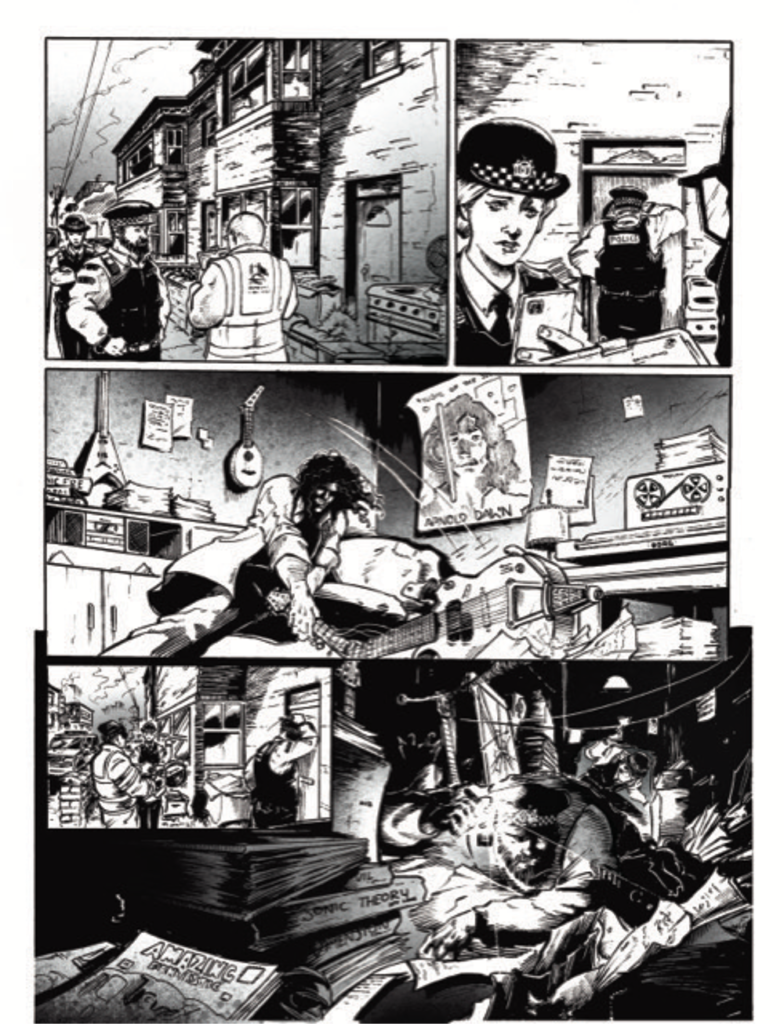
his version of Kek-W’s Tharg’s Terror Tales: Music Of The Spheres, originally drawn by Dan Cornwell
For both of you – I’m assuming this is either your first professional comics work or some of your first at least- but how did you both get to this stage?
MW: I’ve been drawing comics since I was 17, after being encouraged heavily by a college tutor to pursue it, within a year I knew that I wanted to do this for a living so I spent a good few years just drawing my own stories.
After a period of time I felt I needed to do more so I went to Staffordshire university to study Cartoon and Comic arts, I graduated around 3 years ago and haven’t really ever stopped making comics since. Even if I take a tiny bit of time away from it, comics just seem to creep back in and I can’t stop myself from drawing them.
TW: This is my first professional writing gig at all, but I’ve been training to write for at least six years. This involved getting regular feedback from Script Executives and setting harsh deadlines for myself. I suppose, being able to secure a chance to write for 2000 AD is the satisfying culmination of this for me.
Have you been published anywhere, either in fanzines or your own material?
TW: I helped edit a true crime book my father was self-publishing about a grisly murder that took place in Blackburn, my hometown. It was a real joy to help my father bring this passion to life. But other than this, I have never been published anywhere.
MW: I’ve previously been published in comics published by Futurequake press, I think I drew around 5 or 6 stories for them, the two biggest stories I got to do (at least in my mind) were Rogue Trooper and Dredd. It wasn’t official 2000 AD, but it still felt like a huge deal to be drawing such legendary characters.
Yes, sadly that route for prospective droids for Tharg has been closed off since the tragic death of Bolt-01 and the end of Futurequake Press, which many script and art droids found was a great training ground for their development.
MW: Yeah, I did some strips for them for quite a while, I was actually in the process of working on a MACH 1 story when Bolt-01 tragically passed away, so there’s about 12 pages of that which will never see print unfortunately. I’ve considered finishing it up at some point for fun as I’ve still got the script somewhere.
TW: Yes, I’m afraid I wasn’t ever involved in Futurequake. But it certainly sounded like a phenomenal resource for people who wanted to gain skills and experience.
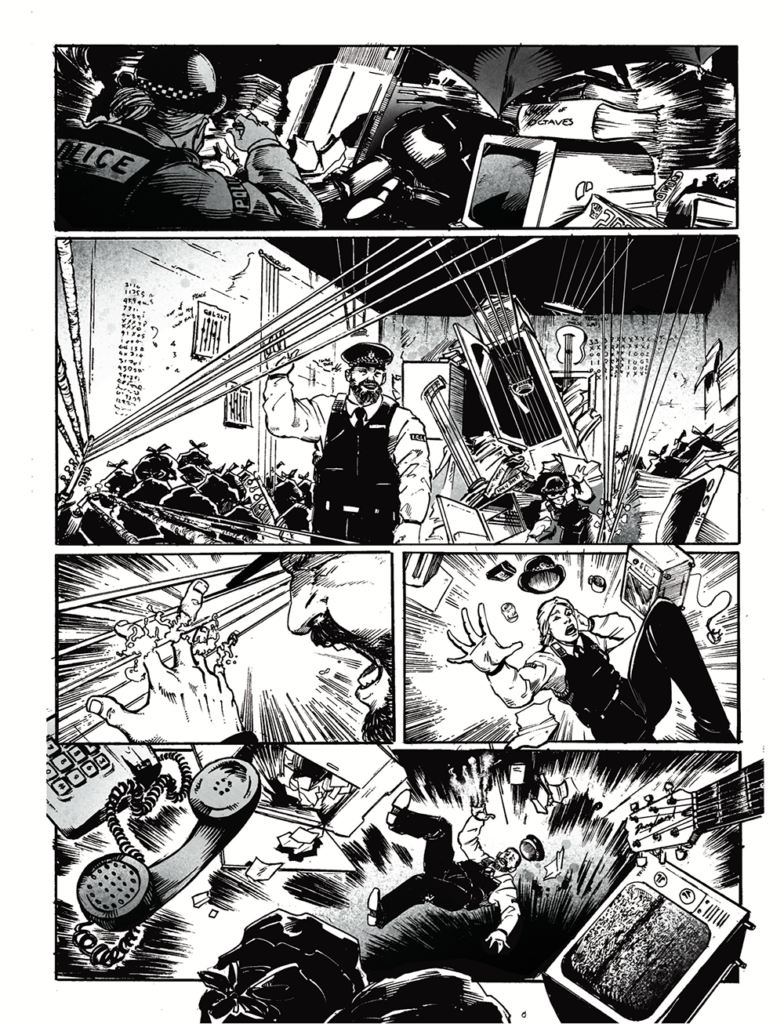
his version of Kek-W’s Tharg’s Terror Tales: Music Of The Spheres, originally drawn by Dan Cornwell
And thinking about how writers and artists get to the level that you’re now at, that level of pro-publication with something like 2000 AD, what sort of things have you done to progress and improve to get to professional standard?
TW: I’ve been writing almost every day for at least six years now. But writing into the void isn’t as good as getting consistent feedback on your work. At university I took every writing course I could get my hands on, and since graduating I’ve spent most of my hard-earned money on direct training from Story Executives in Hollywood. It’s not always been easy. In fact, there have been many times that I wished I hadn’t ever wanted to write! But I loved doing it enough to keep going. To other prospective writers, I would recommend finding a mentor!
MW: Well I don’t feel even remotely “pro” as of yet, to be honest even when the prog is out and I can see my art in print I don’t think I’ll feel like a “pro”. But that being said, I love nothing more than getting critique from actual pros. One of my favourite moments from Thought Bubble 2017 was being told flat out to my face by an artist that my inking was… well he used a four letter word to describe it. Some people don’t like this kind of feedback, however I find it very helpful as there’s no sugar coating, it’s straight to the point and being that I’m a competitive type of person, I like proving people wrong. Ironically Matt Smith praised my inking this year, so take that, artist who shall remain nameless!
.
Well, with that mention of your inking, it seems a perfect time to ask you about your own artistic process. How do you construct your pages?
MW: When I read a script of any story I generally make notes in my head of what angle etc I want and how I want that page to play out, I see it very much like watching a film in my mind, if it’s a well-written script the layout stage is usually fairly easy to do.
I do my layouts on my iPad in procreate, this is purely to save paper and time, as on occasion I’ve wasted a lot of paper scribbling out ideas and throwing them in the bin, in this case there’s no need for a bin, I just press undo.
.
Initially, I was going to draw the whole strip on procreate, but very quickly I found that I wasn’t going to get the outcome I was looking for, at this point I switched to paper. For drawing comics I use Schoellershammer Bristol board, mainly because it comes in pads of 50 sheets rather than the standard 20 sheet packs you get in art shops, on top of that it’s just really good quality paper.
A lot of people blow up their rough layouts and trace them onto their art paper but unfortunately, I don’t have the tools necessary to do this, so I opt to just draw the entire thing from scratch, tweaking each element as I go and always referring back to the script and my initial layout if there’s any confusion.


As you can see my first pass of pencils is very loose and I focus purely on gesture as opposed to detail, I use very hard leaded pencils for this as they’re easier to erase if I make mistakes (generally for my first pass I’ll use a 4H lead)
When penciling I am a little all over the place in that sometimes I might pencil super tight and have every line be exactly where I want it, other times I’ll keep it much more loose and trust my inking skills to get the job done.


During the judging panel, I was asked by Steve Yeowell if I use reference for my faces, as it was something they all praised quite a bit. For the initial layout I don’t as I feel that overuse of reference particularly for faces or figures can make things look particularly stiff.
The only reference I use for faces is an app I have on my phone which has a series of rotatable 3D head models with adjustable lighting (the app is called Head Model Studio on the Apple app store if anyone wants to get it). I use this as more of a guide than anything, just to get the basic shading down, particularly when heavy shadows are involved.
.
For my general pencils I still use wooden pencils, many artists use mechanical ones or those weird clutch pencil things but they just never agreed with me. It’s annoying because it means that I’m constantly sharpening my pencils, but mechanical pencils always felt a little too clinical to me.
For inking I use fineliner pens, at the moment I’m using a set of Uni Pin fineliners because they’re easy to find and give a pretty good line, for most linework I tend to gravitate toward the 0.3 pen.
,
A couple of old favourites now… When it comes to 2000 AD, have you been a lifelong fan or was it something you came to later in life? (Well, I say later in life, for all I know you’re mere children – or at least relatively! How old are the pair of you?)
MW: I started reading 2000 AD when I went to university at about 21, so it’s been about 6 years or so now. Being that one of my tutors, the great John Charles is a colourist there, and with some of my friends being big fans, I had to see what all the fuss was about. Needless to say I wasn’t disappointed. I pulled out all my Progs recently and well, I have a lot more than I thought… later that day I went and bought this week’s Prog. It’s like an addiction really – haha.
TW: I’m 29 years old, but some of my earliest memories are my father reading Judge Dredd to me (to my mother’s dismay). I was familiar with the characters from a very young age, and it certainly inspired me to become a writer. Just because it brought my father and I so much joy when we were together – and it still does!
And if you could get your hands on any 2000 AD character, what would be your dream gig for Tharg?
MW: Dredd, without question. Although I’d also love to have a crack at Sinister Dexter too. Truth be told I’m happy to draw anything, just throw your scripts at me!
TW: Probably Bill Savage. I love how his stories always play around with the morality of “how far will you go to save your country?”. Each character in the story has a different moral limit, and some of the people Bill is fighting can be really nice guys! It’s just so beautifully done.

his version of Kek-W’s Tharg’s Terror Tales: Music Of The Spheres, originally drawn by Dan Cornwell
What about those writing and artistic influences? What/who is it that you owe a debt to?
MW: In terms of artistic influences I must confess that many of mine come from more American comics rather than 2000 AD, my two biggest being Greg Capullo and Todd McFarlane. That being said I’m a big fan of guys like Brian Bolland, Ron Smith and Dave Gibbons.
TW: 2000 AD definitely! The stories I’m mostly drawn to involve action, horror and science-fiction in some way. But I certainly owe a debt to my writing teacher John Truby, the author of the Anatomy of Story. When I read his books on how to write, they were invaluable. Also, movies from James Cameron & Christopher Nolan have some great lessons for writers to learn in them.
And now that you’re on the first steps of your 2000 AD journey, what are the next steps for you – what’s coming up for you in the near, or not so near future and where would you like to think you’ll be in a few years’ time?
MW: At this moment in time I’m just anticipating the Future Shock script, I can’t wait to get started. From there I guess I’ll see what the future brings, hopefully more strips to draw!
TW: I’d love to be able to write more stories for 2000 AD, but I know this decision is not ultimately up to me! Right now, I’m just happy to get the chance to write a Future Shock and hope our readers enjoy it.
For the future? I’d like to see both of the novels I’m working on published – one of which is a horror story set in the Lake District about two brothers fighting the undead. But I’ve learned to leave some of the future up to chance!
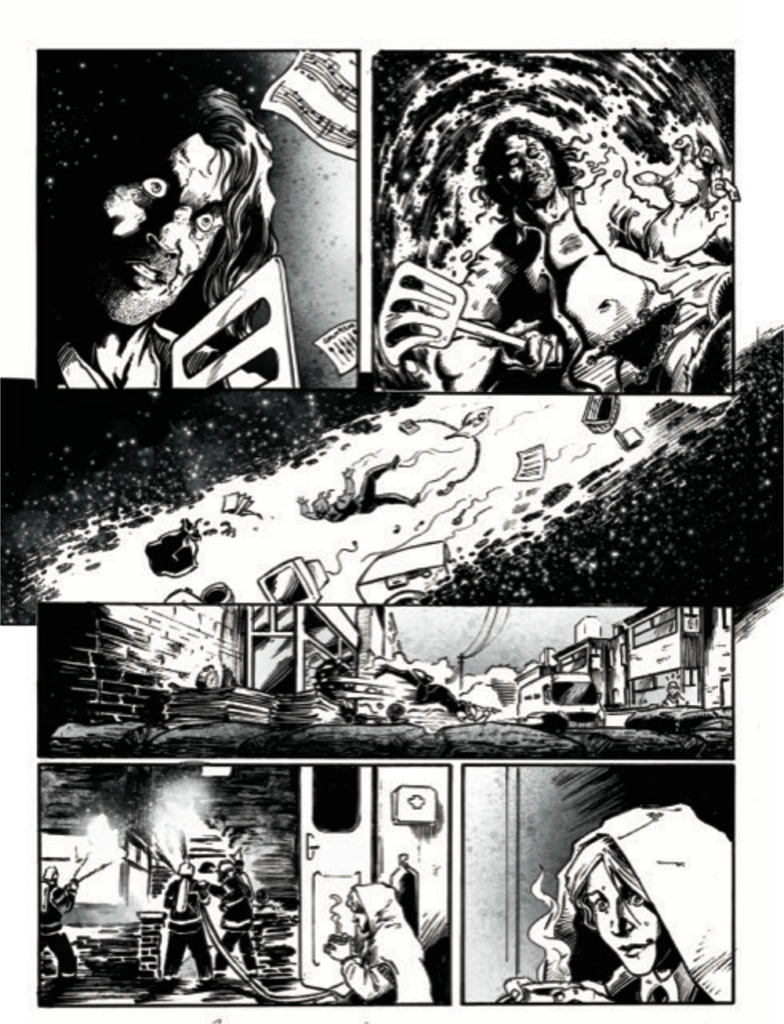
his version of Kek-W’s Tharg’s Terror Tales: Music Of The Spheres, originally drawn by Dan Cornwell
Well, thank you so much to Matt and Mike for talking to us – and congratulations again to both of them for their wins. We’ll look forward to seeing the fruits of their labours in 2023!
You can find both of them online at all the usual places… Tom Watts – Instagram & Mike Walters – Twitter, Instagram.
And remember, 2000 AD will be back at Thought Bubble in 2023 on the hunt for more new talent – have you got what it takes to fill the pages of the Galaxy’s Greatest Comic with thrill power? There’s only one way to find out Earthlet!

